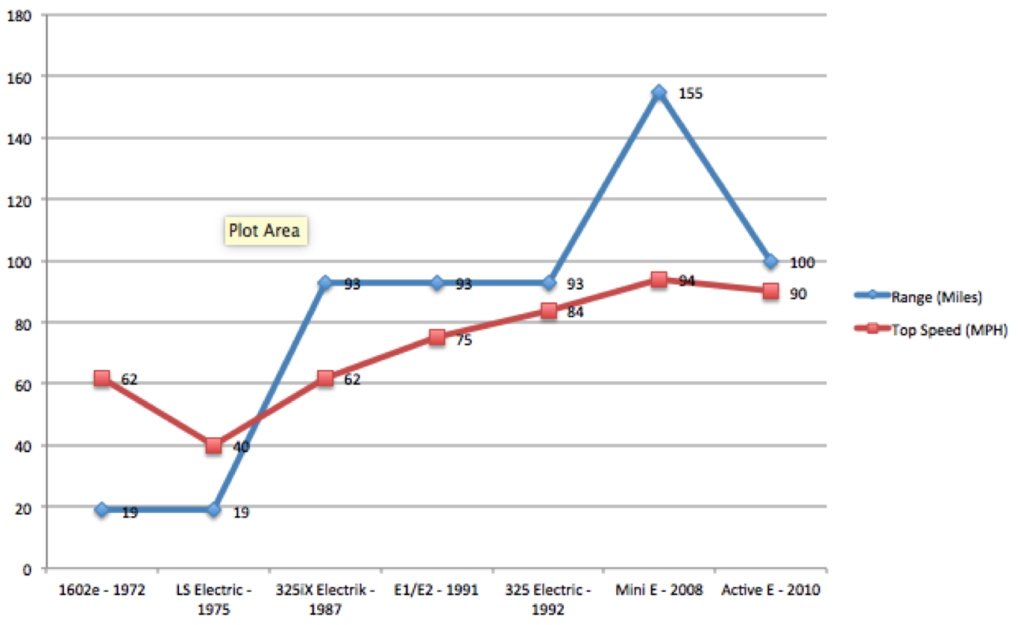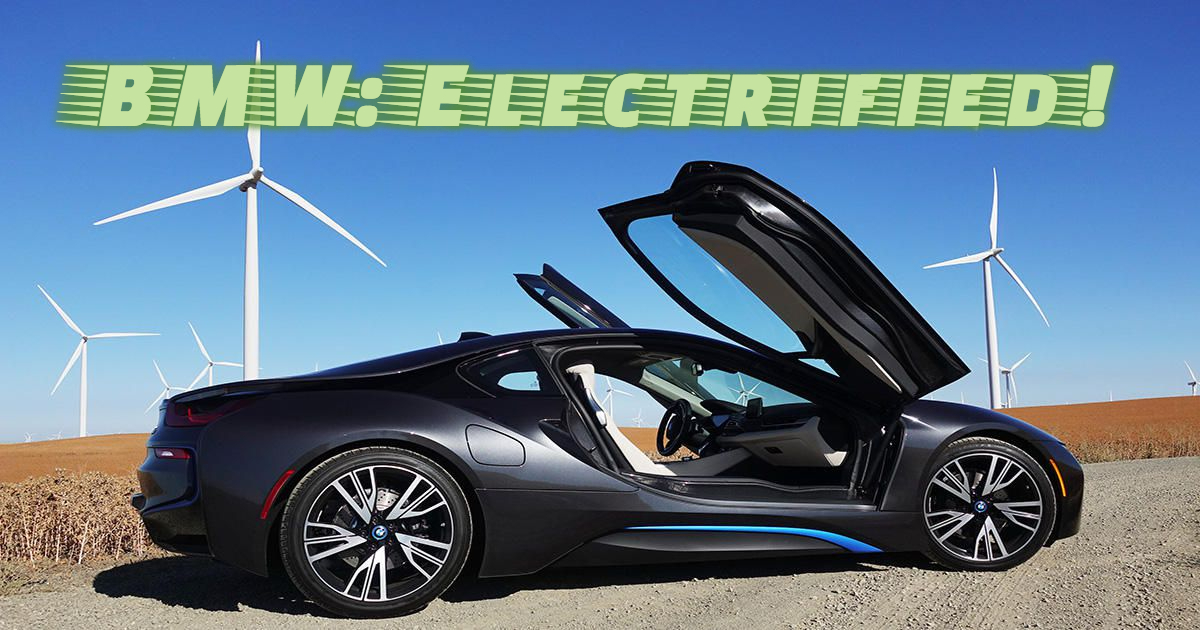Many of us know the story of BMW’s foray into electric vehicles. Though not as aggressive as, say, Volkswagen, GM or even many Japanese carmakers like Nissan, BMW’s romance with electrification goes back several decades. If you think this is a success story, think again. This is the story of BMW’s failure to capitalize on its technology advantage over nearly half a century, and why the company needs to commit completely to the inevitable EV avalanche that is headed our way.
Did you know that BMW made its first electric car back in 1972? Yes, it was called the 1602 Elektro-Antrieb, or simply 1602e, and it had an in-city range of just 19 miles on a full charge.
During the Munich Olympics that year, the 1602 was used as the pace car for long-distance events so the athletes wouldn’t have to inhale combustion engine fumes.
It used an array of 12X12V batteries from Varta weighing a total of 771 lbs, and an electric motor from Bosch, to give a top speed of 62 mph. If you drove it at a steady 31 mph, or half the top speed, BMW said it could double the range to 38 miles. But with that kind of range it was doomed to failure, especially when gasoline cars at the time were giving about 13.5 miles per gallon and the BMW 2002 was giving at least 20 mpg.
The interesting thing about the 1602e is that it was made right before the oil crisis of 1973. That was the first sign that the Western world should have given serious thought to electrification, but it never happened. And it didn’t happen during the “second oil shock” of 1979, either.
Nevertheless, BMW kept plodding its way through electrification, and went through a series of models that were used for various purposes, including delivering the mail! Here’s an interesting graph that shows you how much range each of those models had, and their top speeds.

As you can see, across seven unique series of EVs and about 38 years BMW managed to go from 19 miles to 155 miles of range, and 40 mph to nearly 100 mph in terms of top speed. Indeed, the results were slow and it took years for BMW to achieve anything close to what a road car would require. In fact, of all these models, only the last three actually made it to the road. The 325 Electric had about 25 cars built during the 90s, and were given to the postal department and government officials. The Mini E was a little more prolific, and about 600 of these were leased out to the general public for about $850 a month including insurance and charge station access. The Active E, with was a 1-Series BMW, saw about 1000 units leased to the public. Unfortunately, none of them hit the market, but all that know-how allowed BMW to be poised and ready for its next revelation: the i3.
Of all the attempts BMW made in the area of electric vehicles, the i3 has had the most impact. It was so successful, in fact, that BMW has been offering the i3 in a new version every year since the original release in 2014. The original edition offers upto 100 miles of range on pure electric version, and the Range Extender version pushes that up to 185 miles with a two-cylinder gasoline engine.
The price hasn’t changed much over the years, and a 2018 i3 still comes with an MSRP of under $50,000. But the range on the pure EV version is now 114 miles.
Although BMW went pure-EV for a long time with its experimental vehicles, it couldn’t really risk the brand’s reputation with sub-par range or power. Despite the years of experience and experimentation, BMW failed to hit the nail on the head when it came to battery technology.
And, hence, the i8 hybrid monster, capable of delivering a total output of 369hp and 420 lb-ft of torque. 0-60 mph in 4.2 seconds is what a BMW buyer would expect, but the power is delivered not only by an electric motor, but also a combustion engine, which makes it a deal-breaker for EV purists.
Nonetheless, no matter what its weaknesses, the i8 is by no means a weak car. Bringing perfect balance to the power vs. efficiency equation is what the i8 is all about, and BMW has delivered on that front. The eDrive mode, which is the pure electric experience, offers a not-too-shabby top speed of 75 mph.
The only problem is the starting MSRP of $147,500. For that kind of money, you can get a fully loaded Tesla Model S P100D will all the bells and whistles included. Besides, you’d be getting fully Autopilot capability, 400 kWh of free annual Supercharger credits, 315 miles of range, a top speed of 155 mph and a 0-60 mph acceleration time of 2.5 seconds!
And that’s the essence of the problem faced by nearly every company today that has an EV agenda, which is almost every major car manufacturer in the world. And the reason for that is battery costs.
Audi last year revealed that it had achieved a cost of about $114/kWh of battery power. For a 95 kWh battery that would cost about $10,830, and I’m talking about just the cost of the battery alone. General Motors is a little more conservative, with their cost pegged at around $145/kWh, which they believe will drop to below $100/kWh by 2021. Tesla has been the frontrunner so far in reducing battery costs, and with mass production of Model 3 the cost could go below the $100/kWh target cost sooner rather than later.
But BMW has never been about the mass market, and it doesn’t cater to low-end pricing. That’s not to say that the company hasn’t stretched its pricing at the lower end to attract more high-income groups and thereby expand its addressable market, especially with its 2-series and 3-series entry-level premium models, but BMW has been and always will be a premium brand. Just like Apple is not likely to ever release a $200 iPhone, don’t expect BMW to try and break the under-$50,000 price barrier for automobiles the way Tesla and GM are doing.
That doesn’t mean BMW is sitting still on the battery tech front. The company knows that the EV segment is where the biggest gains will be made in the future, so it has invested in a new partnership with Solid Power, a startup that claims to have made a major breakthrough in battery technology. Its solid-state cell with an energy capacity “2-3X higher” than conventional lithium-ion could be a game-changer for BMW, as well as the EV market.
Solid Power is yet to build its newest prototypes, but late last year it announced that it was moving into a larger facility and preparing for another round of prototypes.
With this effort, BMW joins companies like Hyundai, Toyota and Fisker in the race to create the solid state EV battery of the future. The most aggressive timeline has been set by Toyota, which is 2020. With its vast experience in mass-market EVs, Toyota is well-positioned to take advantage of the changing landscape in the auto segment.
As for BMW, it would appear that nearly 50 years of playing with electricity has given it little to no advantage in the race to produce high-range, high-power EVs that can take on the market leader, Tesla Motors.
The biggest problem appears to be that BMW is caught in a web of its own making.
The crux of that problem is the reputation that BMW has built for itself. Luxury is one thing, but performance is something that every BMW owner has come to expect as a matter of fact. They’re looking for power; for acceleration; for that thrill of stepping on the gas and getting stuck to the seat. That’s not something you can deliver with EVs unless your tech is far more advanced than the others. And that’s why none of the company’s electric efforts ever made it to the mainstream market until the i3.
With the i8, BMW may well invoke a rise in demand for high-end electric vehicles from the German auto giant.
It’s too early to tell, but it’s never too late to begin.
And that’s the sad truth about BMW’s electrification efforts over the past five decades.



